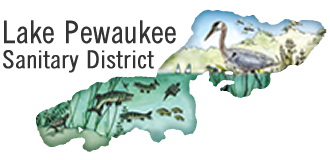[hdwplayer id=2]
The number one priority is harvesting the aquatic plants along the outside of the piers to allow access around the whole lake and to get boats in and out from shore.
The second priority is to cut access lanes through the heavy mats that tend to develop in the shallow bays around the lake. Cutting access lanes allows boat traffic to get in and out as well as provide “predator channels” for game fish to feed in. The pan fish in Pewaukee Lake have become slightly “stunted” in growth due to the large population and the heavy aquatic plant growth that allows gives them a place to hide in. These “predator channels” will help address that issue as well as allow the lake users to pass through the otherwise inaccessible areas. Our goal is to make these channels wide enough for boat traffic in both directions at the same time and keep these free of aquatic plants while still maintaining priority number one. All this takes a lot of time and staff. At the same time we also need to keep the shorelines free of the floating plants which can clog up boat lifts, make it difficult to fish off the piers and swimming undesirable.
To date, with the heavy growth, we are keeping up with the floaters and keeping the channels free for traffic. The extra benefit of channels are the simple fact that people use them and it really cuts down on the amount of floaters that are created from prop shop. Eliminating the floaters pleases the skiers, boaters, wave runners, swimmers and fisherman and it allows us more time to cut aquatic plants.
The third priority is topping off the large mats. Most of the heavy mats are in shallow areas and bays. These areas typically include Buena Vista (Crystal Springs/Maple Avenue), Glen Cove, Auer Park, Starkey Bay, Peninsula Bay, Woodland, Peterson, Kopmier and Parkside. Most of these locations are in areas where soils are very silty which make up ideal conditions for aquatic plant growth. Remember most of these areas were swamp land or very shallow before the dam was installed and the lake was flooded. Please understand these areas will never be a “gravel bottom blue swimming pool” free of weeds and silt. However as time permits and the lake users continue to use the channels, we can continue to minimize the size of the mats as time permits. Removing the heavy mats will help improve access, it will help the fisheries and it helps the aesthetic appearance of the lake, it’s simply a matter of time, money and equipment. Let’s use cutting out the shallow inside of Peninsula Bay for example: First of all we are not permitted to cut right to the bottom. A short stand of aquatic plant is required to hold the sediment together with the root systems as well as provide a minimal amount of cover for the fish and critters. Second even if we were permitted to cut to the bottom, the harvester’s blades are on an angle and as you move forward the plants tend to bend over so you really end up leaving 12 inches of plant material anyway. The bays typically have large rocks that are difficult to see so damaging the harvesters becomes a high risk. Once damaged, they are shut down and in for maintenance which means they are not available for keeping the piers and lanes open. Now factor in the aquatic plant growth rate. You managed to cut 12” of plant out and during this peak time of growth, how long is it before the aquatic plants are back to the surface? A week? If we used chemicals and it killed the weeds and created sediment, how deep will the bay be in 20 years? If we did this along Woodland, Peninsula and Kopmier it may become inaccessible all together with our large heavy harvesting equipment. It could possibly become a large stand of cattails instead of the water and aquatic plants you see today.
Lastly, if we did want to move forward with crews to try to accomplish this during peak growth years it would take an increase in equipment, maintenance and labor which leads us to budgets. Lake property owners in the bad areas may be willing to pay extra but lake property owners in areas with little growth may not. If we special assess the people in the bad areas and then spend more time there, the people in the good areas may think they are not getting their normal service. If we increase or double the tax levy, people that are not on the lake think that is unfair. There will be lots to talk about in the future as we work towards developing a new Lake Management Plan for this constantly changing ecosystem we have on Pewaukee Lake.






